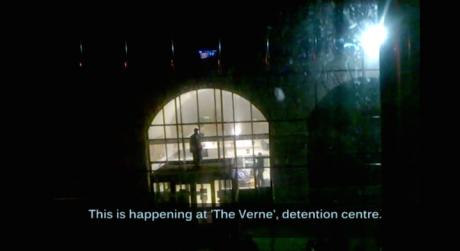Satisfactory? The UK immigration lock-up that Samaritans dare not visit


This is the second death at The Verne in 14 months. The detention centre, a converted fortress on the Isle of Portland, holds almost 600 men, over half of them ex-prisoners.
Yet Nick Hardwick, the chief inspector of prisons, wrote: “Overall, The Verne was operating satisfactorily,” — in an inspection report published days before the
latest death.
His report’s own findings contradict that conclusion, and suggest that suicide prevention work at the Verne is particularly inadequate.


The charity tells me it is now providing a reduced service there.
Hardwick’s report on The Verne reveals: “levels of violence were too high and some of the violence was serious.”
The week before the inspection, there was what Hardwick euphemistically called a “concerted indiscipline” (commonly known as a riot), involving over a hundred detainees. It was “sparked by a detainee tying a noose around his neck and going onto a roof. … and the subsequent disturbance caused considerable damage to property.”
The detainees offer their account with a covertly-filmed video here. It is harrowing stuff.
In the six months before the inspection, “24 detainees had harmed themselves and some incidents were serious near misses”, according to the report.
How were people on suicide-watch cared for? Hardwick says: “there was no care suite and detainees requiring constant observations were held in an austere gated cell in the separation unit … Holding detainees in crisis in such poor conditions was inappropriate.”
Inappropriate.
This separation unit “was poor and it was used frequently. Some detainees were held there for several weeks”.
There was little natural light, “which created a rather oppressive environment. Most rooms were dirty with graffiti and some toilets were filthy”.
If they wanted a breath of fresh air, perhaps to get away from the smell of excrement, then “the exercise yard was stark and cage like”.
Remember, this is where suicidal detainees were being kept, “because of a lack of more suitable accommodation”. That’s concerning.
Inspectors noted: “Thirty-nine detainees had been held for more than a year, with the longest held for five years, one of the most shocking cases of prolonged detention we have seen.” There was no reasonable chance of him being deported, the report says; he had no passport.
“For years the Home Office had accused him of failing to cooperate with his re-documentation,” but they had not tried to prosecute him for non-compliance before a judge.
An absence of due process, and, in the report’s own words, “shocking”.
The Verne, which is a converted Victorian fort (the moat survives), used to be a prison. Hardwick wrote: “The centre still looked and felt like a prison and there was an unnecessary amount of razor wire,” much of which had gone up recently.
The Verne is peculiarly isolated — on the Isle of Portland, which is joined to the Dorset mainland by a single windswept causeway, half an hour’s drive from Weymouth railway station.
The prison inspectorate’s survey revealed that just 19 per cent of detainees had been visited by family or friends, compared with an average of 43 per cent for other immigration detention centres. Only a quarter of lawyers had managed to visit their clients.
The mobile phone signal is patchy. These people are really cut off.
The Isle of Portland has a long penal history, of which the Verne detention centre is just the latest chapter. From 1848, convicts were bought to
the isle for forced labour in the limestone quarries, before deportation to Australia. The inmates included Irish Republicans detained after the Fenian
Rising of 1867. The Verne’s location is a reminder that Britain’s addiction to banishing the ‘other’, be they ex-offenders or terror suspects, is nothing new.
This piece was first published by Shine A Light at openDemocracy.
